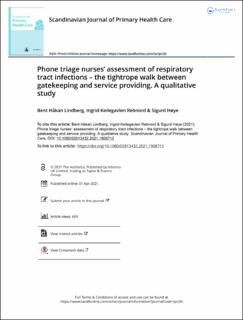| dc.contributor.author | Lindberg, Bent Håkan | |
| dc.contributor.author | Rebnord, Ingrid Keilegavlen | |
| dc.contributor.author | Høye, Sigurd | |
| dc.date.accessioned | 2022-02-01T13:41:31Z | |
| dc.date.available | 2022-02-01T13:41:31Z | |
| dc.date.created | 2021-05-07T10:59:49Z | |
| dc.date.issued | 2021 | |
| dc.identifier.citation | Scandinavian Journal of Primary Health Care. 2021, 39 (2), 139-147. | en_US |
| dc.identifier.issn | 0281-3432 | |
| dc.identifier.uri | https://hdl.handle.net/11250/2976305 | |
| dc.description.abstract | Aim To measure change in service user involvement in secure mental health units, before and after the implementation of recovery-oriented practice. Design Quasi-experimental study pretest–posttest design with non-equivalent comparison groups. Methods Data were collected from May 2018 to December 2019 in four medium-/high-security units in Norway. Two intervention units that implemented recovery-oriented practice were compared with two comparison units that did not. Data were obtained using anonymous questionnaires at baseline and at 6-month follow-up. For intervention units, data were also obtained at a 12-month follow-up to measure sustainability of improvements over time. Twenty inpatients (‘patients’; intervention group: 10, comparison group: 10) and 141 members of frontline staff (‘service providers’; intervention group: 92, comparison group: 49) participated at baseline. Mann–Whitney U-tests and independent sample t-tests were applied at the group-level to analyse changes in mean scores in groups. Results Among patients in the intervention units, findings indicated no improvements after 6 months, but significant improvements after 12 months in terms of patients’ opportunities to participate in formulating their individual care plans, to influence decision-making about therapy and to receive information about complaint procedures. Opportunities to participate in discussions about medication and treatment regimens did not improve. After 6 months, service providers in the intervention units reported an increase in democratic patient involvement, patient collaboration and management support, but not in carer involvement and assisted patient involvement. The improvements in democratic patient involvement and management support were sustained over time. No changes were found in the comparison groups. Conclusion The patients and the service providers reported a higher degree of service user involvement after implementing recovery-oriented practice. Specific work is needed to ensure patients’ involvement in all domains. | en_US |
| dc.language.iso | eng | en_US |
| dc.rights | Navngivelse 4.0 Internasjonal | * |
| dc.rights.uri | http://creativecommons.org/licenses/by/4.0/deed.no | * |
| dc.title | Phone triage nurses’ assessment of respiratory tract infections–the tightrope walk between gatekeeping and service providing. A qualitative study | en_US |
| dc.type | Journal article | en_US |
| dc.type | Peer reviewed | en_US |
| dc.rights.holder | © 2021 The Author(s) | en_US |
| dc.description.version | publishedVersion | en_US |
| cristin.ispublished | true | |
| cristin.fulltext | original | |
| cristin.fulltext | original | |
| cristin.qualitycode | 1 | |
| dc.identifier.doi | 10.1080/02813432.2021.1908715 | |
| dc.identifier.cristin | 1908707 | |
| dc.source.journal | Scandinavian Journal of Primary Health Care | en_US |
| dc.source.volume | 39 | en_US |
| dc.source.issue | 2 | en_US |
| dc.source.pagenumber | 139-147 | en_US |

